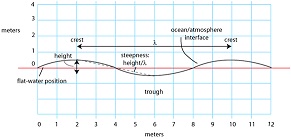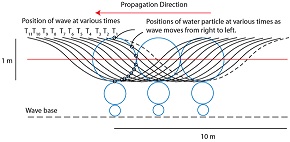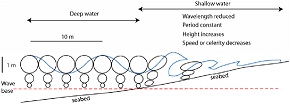Reference no: EM131483371
Oceans -
How do ocean waves form?
"All waves are disturbances of a fluid medium through which energy is moved" (Davis, 1997). Ocean waves travel on the interface between oceans and the atmosphere, and are produced most commonly by winds.
As shown in Figure 1, the crest of a wave is its highest point while the trough is the lowest. The height of the wave is the vertical distance between the crest and the trough. The wavelength (λ) is the horizontal distance from crest to crest or from trough to trough. The steepness is the ratio of its height to λ. When the steepness value reaches 0.143 (i.e., a ratio of 1:7), the crest of the wave breaks. Note that a steepness value less than 0.143 means a stable wave while one larger than
means an unstable breaking wave.

Using Figure 1, please answer all of the following questions.
(1) What is the height of the illustrated wave?
(2) What is the wavelength?
(3) What is the steepness?
(4) Will the wave break given your answer to question (3)? Please briefly explain your answer.
(1) What is the steepness of the wave that you sketched?
(2) Will the wave break?
When the interface between the oceans and the atmosphere is disturbed by a force, then waves form. Most commonly that disturbing force is the friction of the wind moving across the water. Once the wave has formed gravity acts against this disturbance, and attempts to restore the water/atmosphere interface back to its flat-water position (i.e., a horizontal state).
Hence, wind-generated waves are sometimes referred to as gravity waves. As gravity pulls the crest of a wave downward, momentum carries the water/atmosphere interface beyond the flat-water position to form a trough. As a result, a buoy will appear to move up and down without being translated in the direction that the
waves appear to be moving. Such up and down motion will continue as along as the wind is blowing. When the wind stops blowing, the water/atmosphere interface returns to its normal flat-water state.
The period of a wave is the time it takes for one wavelength to pass a reference mark. The periods for normal ocean waves range from a few seconds to about 15 seconds.
Note that this differs from wave celerity which is the speed at which a wave advances or propagates. Mathematically, wave celerity in deep water is simple 1.56/period (m/sec) or 5.12/period (ft/sec). Deep water waves are waves that occur in water depth that is greater than one half their wavelength.
(1) If it takes 10 seconds for 1 wavelength of the wave that you sketched in Figure 2 to pass the end of Scripps pier, then what is the period of the wave?
(2) What is celerity of the wave?
(3) If the wave passing the end of Scripps pier had the wavelength of the wave shown in Figure 1, but nonetheless took 10 seconds for 1 wavelength to pass, then what would its period be?
(4) What is the celerity? Did this wave advance faster or slower than the wave in Figure 2?
The size of a wave increases as the speed, duration, and fetch of the wind increases. Fetch is the extent of the open water over which the wind travels. A slight breeze over a calm sea can generate a series of ripples, i.e., waves with a period of less than 1 second.
The generation of ripples provides the wind an elevated surface across which it can push. In so doing it transfers energy to this surface, and, as a result, the small waves (ripples) begin to grow increasing their height and period. Wind blowing for many hours and over a great distance (long fetch) will result in very large and powerful waves.
You can demonstrate the fact that blowing wind can produce waves by blowing a breath of air across a pan of water. Try it. Your breath is analogous to a large storm in the NW Pacific.
Though many students think that water is moving in the direction of wave motion it turns out that this perception is not correct. If you think about it, you actually have observed things like fishing boats remaining stationary as a swell passes beneath them, or a fishing bob moving up and down as small waves or ripples pass beneath along a lake or bay shoreline.
If the water was moving with the waves, then each of these items should have been translated along with the wave. What actually happens is that water particles within the wave are moving forward on the crest and backward on the trough, with vertical motion occurring between the two. The exact path that they follow is circular. For example, shown in Figure 3 are 11 different positions of a wave that is moving from right to left. The position of a particle of water time 1 (T1) is shown at the crest of the wave.
As the wave moves to the left at times 2 (T2) - 11 (T11) that same particle will appear to move downward in a circular path.
On Figure 3 use your colored pencils and show the positions a water particle will occupy if it starts out in the trough of the wave at time 1 (T1).

Figure 2. Circular path taken by a water particle as a wave moves through a column of water from right to left.
In the open ocean the circular paths followed by water particles decrease systematically downward until a depth of 0.5*λ. This depth is known as wave base (Figure 3). Below wave base water particles do not feel the wave. In contrast, as waves near the shore, the water depth decreases and results in a dramatic change in the wave character.
What happens to waves as they encounter shallow water?
As deep water waves move toward adjacent shores they progressively encounter shallower waters. Eventually, they will begin to feel the bottom when the depth of water is less than one half their wavelength. At this depth the circular orbits that water particles are following come into contact with the seabed and the wave begins to travel slower as wavelength is reduced, and wave height increased. In contrast, the wave period remains constant.
The friction produced by the wave encountering the seabed causes the circular paths of water particles to be squeezed into elliptical forms, and as water depth continues to decrease these paths eventually become simple back and forth motions parallel to the seaward dipping seabed. Because the friction between the advancing wave and the seabed is greatest lower in the wave than higher in the wave, the speed of advancement of the wave at this depth is more greatly reduced than it is higher in the wave. The contrast
in speed of advancement with depth leads to an unstable wave form with the upper part outracing the lower part, a circumstance that eventually leads to collapse in a breaker.
When water depth is about 1/25 the wavelength (0.04 * λ) waves are said to be in shallow water. At this depth water particles follow strongly elliptical back-and-forth motions (see Figure 4). The celerity or speed of advance of a shallow water wave in the metric system is 3.13 times the square root of the water depth (m) (m/sec). In the English system celerity is 5.66 times the square root of the water depth (ft) (ft/sec).

Figure 3. The change in particle paths as waves encounter shallow water.
If the wavelength is 10 m, wave height is 1 m, and the period 10 sec, then in Figure 4 at what depth is wave base?
At what depth would the wave be considered to be in shallow water?
What are tsunami and how do they differ from normal ocean waves?
The term tsunami means in Japanese "harbor wave", the location where the Japanese most feared them. Tsunami are sometimes referred to as tidal waves.
Tsunami originate when a large magnitude earthquake or landslide suddenly shifts or displaces a large amount of seawater. The result is a train of waves migrating away from the center of disturbance, a configuration that resembles the concentric waves emanating outward from the disturbance created by tossing a stone in a lake.
Tsunami move at great speeds sometimes up to 800 km/hour. Wavelengths are on the order of 150 km or more while wave height is about half a meter or so.
If the wavelength of a tsunami is 1500 m, then at what depth would it begin to feel the seabed?
After viewing a bathymetric map of offshore California how far off shore would a tsunami with a wavelength of 1500 m begin to feel the bottom?
Tsunami that begin to steepen at great distances from the shore will continue to steepen as they advance toward the continental mainland or island in its path. Some tsunami are known to have grown to 25 m or more. Prior to December 26, 2004 the most life destroying tsunami on record hit Awa, Japan in 1703, killing 100,000 people.
You will have to do some web-based research to answer the following questions:
(1) What is the current death toll resulting from the December 26, 2004 tsunami that originated in Sumatra?
(2) What is the largest wave height reported for the December 26 tsunami?
(3) What is the estimated speed of the December 26 tsunami?
(4) What was the wavelength of the December 26 tsunami?
(5) What was wavebase for the December 26 tsunami?
Please provide your references to the above questions below.
References
Many of the above ideas are from the following excellent book:
Davis, R.A., Jr., 1997, The Evolving Coast, W.H. Freeman and Company, New York, 233 p.